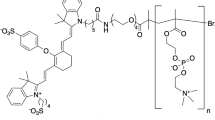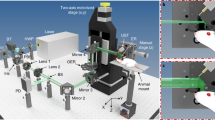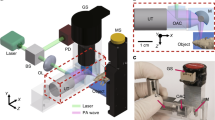Abstract
Photoacoustic tomography (PAT) of genetically encoded probes allows for imaging of targeted biological processes deep in tissues with high spatial resolution; however, high background signals from blood can limit the achievable detection sensitivity. Here we describe a reversibly switchable nonfluorescent bacterial phytochrome for use in multiscale photoacoustic imaging, BphP1, with the most red-shifted absorption among genetically encoded probes. BphP1 binds a heme-derived biliverdin chromophore and is reversibly photoconvertible between red and near-infrared light-absorption states. We combined single-wavelength PAT with efficient BphP1 photoswitching, which enabled differential imaging with substantially decreased background signals, enhanced detection sensitivity, increased penetration depth and improved spatial resolution. We monitored tumor growth and metastasis with ∼100-μm resolution at depths approaching 10 mm using photoacoustic computed tomography, and we imaged individual cancer cells with a suboptical-diffraction resolution of ∼140 nm using photoacoustic microscopy. This technology is promising for biomedical studies at several scales.
This is a preview of subscription content, access via your institution
Access options
Subscribe to this journal
Receive 12 print issues and online access
$259.00 per year
only $21.58 per issue
Buy this article
- Purchase on Springer Link
- Instant access to full article PDF
Prices may be subject to local taxes which are calculated during checkout





Similar content being viewed by others
References
Ntziachristos, V. Going deeper than microscopy: the optical imaging frontier in biology. Nat. Methods 7, 603–614 (2010).
Weissleder, R. & Pittet, M.J. Imaging in the era of molecular oncology. Nature 452, 580–589 (2008).
Rice, W.L., Shcherbakova, D.M., Verkhusha, V.V. & Kumar, A.T.N. In vivo tomographic imaging of deep-seated cancer using fluorescence lifetime contrast. Cancer Res. 75, 1236–1243 (2015).
Wang, L.V. & Hu, S. Photoacoustic tomography: in vivo imaging from organelles to organs. Science 335, 1458–1462 (2012).
Brecht, H.P. et al. Whole-body three-dimensional optoacoustic tomography system for small animals. J. Biomed. Opt. 14, 064007 (2009).
Kruger, R.A., Lam, R.B., Reinecke, D.R., Del Rio, S.P. & Doyle, R.P. Photoacoustic angiography of the breast. Med. Phys. 37, 6096–6100 (2010).
de la Zerda, A., Kim, J.W., Galanzha, E.I., Gambhir, S.S. & Zharov, V.P. Advanced contrast nanoagents for photoacoustic molecular imaging, cytometry, blood test and photothermal theranostics. Contrast Media Mol. Imaging 6, 346–369 (2011).
Luke, G.P., Yeager, D. & Emelianov, S.Y. Biomedical applications of photoacoustic imaging with exogenous contrast agents. Ann. Biomed. Eng. 40, 422–437 (2012).
Kircher, M.F. et al. A brain tumor molecular imaging strategy using a new triple-modality MRI-photoacoustic-Raman nanoparticle. Nat. Med. 18, 829–834 (2012).
Wang, X. et al. Noninvasive laser-induced photoacoustic tomography for structural and functional in vivo imaging of the brain. Nat. Biotechnol. 21, 803–806 (2003).
Zhang, H.F., Maslov, K., Stoica, G. & Wang, L.H.V. Functional photoacoustic microscopy for high-resolution and noninvasive in vivo imaging. Nat. Biotechnol. 24, 848–851 (2006).
Razansky, D. et al. Multispectral opto-acoustic tomography of deep-seated fluorescent proteins in vivo. Nat. Photonics 3, 412–417 (2009).
Krumholz, A., Shcherbakova, D.M., Xia, J., Wang, L.V. & Verkhusha, V.V. Multicontrast photoacoustic in vivo imaging using near-infrared fluorescent proteins. Sci. Rep. 4, 3939 (2014).
Stiel, A.C. et al. High-contrast imaging of reversibly switchable fluorescent proteins via temporally unmixed multispectral optoacoustic tomography. Opt. Lett. 40, 367–370 (2015).
Jathoul, A.P. et al. Deep in vivo photoacoustic imaging of mammalian tissues using a tyrosinase-based genetic reporter. Nat. Photonics 9, 239–246 (2015).
Piatkevich, K.D., Subach, F.V. & Verkhusha, V.V. Engineering of bacterial phytochromes for near-infrared imaging, sensing, and light-control in mammals. Chem. Soc. Rev. 42, 3441–3452 (2013).
Weissleder, R. & Ntziachristos, V. Shedding light onto live molecular targets. Nat. Med. 9, 123–128 (2003).
Giraud, E. & Vermeglio, A. Bacteriophytochromes in anoxygenic photosynthetic bacteria. Photosynth. Res. 97, 141–153 (2008).
Auldridge, M.E. & Forest, K.T. Bacterial phytochromes: more than meets the light. Crit. Rev. Biochem. Mol. Biol. 46, 67–88 (2011).
Shcherbakova, D.M. & Verkhusha, V.V. Near-infrared fluorescent proteins for multicolor in vivo imaging. Nat. Methods 10, 751–754 (2013).
Subach, F.V. et al. Red fluorescent protein with reversibly photoswitchable absorbance for photochromic FRET. Chem. Biol. 17, 745–755 (2010).
Pletnev, S., Subach, F.V., Dauter, Z., Wlodawer, A. & Verkhusha, V.V. A structural basis for reversible photoswitching of absorbance spectra in red fluorescent protein rsTagRFP. J. Mol. Biol. 417, 144–151 (2012).
Xia, J. et al. Whole-body ring-shaped confocal photoacoustic computed tomography of small animals in vivo. J. Biomed. Opt. 17, 050506 (2012).
Lai, P., Xu, X. & Wang, L.V. Dependence of optical scattering from Intralipid in gelatin-gel based tissue-mimicking phantoms on mixing temperature and time. J. Biomed. Opt. 19, 35002 (2014).
Piatkevich, K.D., Subach, F.V. & Verkhusha, V.V. Far-red light photoactivatable near-infrared fluorescent proteins engineered from a bacterial phytochrome. Nat. Commun. 4, 2153 (2013).
Yan, Y., Marriott, M.E., Petchprayoon, C. & Marriott, G. Optical switch probes and optical lock-in detection (OLID) imaging microscopy: high-contrast fluorescence imaging within living systems. Biochem. J. 433, 411–422 (2011).
Toh, K.C., Stojkovic, E.A., van Stokkum, I.H., Moffat, K. & Kennis, J.T. Proton-transfer and hydrogen-bond interactions determine fluorescence quantum yield and photochemical efficiency of bacteriophytochrome. Proc. Natl. Acad. Sci. USA 107, 9170–9175 (2010).
Habuchi, S. et al. Reversible single-molecule photoswitching in the GFP-like fluorescent protein Dronpa. Proc. Natl. Acad. Sci. USA 102, 9511–9516 (2005).
Yao, J. et al. Reversibly switchable fluorescence microscopy with enhanced resolution and image contrast. J. Biomed. Opt. 19, 086018 (2014).
Yao, J., Wang, L., Li, C., Zhang, C. & Wang, L.V. Photoimprint photoacoustic microscopy for three-dimensional label-free subdiffraction imaging. Phys. Rev. Lett. 112, 014302 (2014).
Deliolanis, N.C. et al. Deep-tissue reporter-gene imaging with fluorescence and optoacoustic tomography: a performance overview. Mol. Imaging Biol. 16, 652–660 (2014).
Ntziachristos, V. & Razansky, D. Molecular imaging by means of multispectral optoacoustic tomography (MSOT). Chem. Rev. 110, 2783–2794 (2010).
Xia, J. & Wang, L.V. Small-animal whole-body photoacoustic tomography: a review. IEEE Trans. Biomed. Eng. 61, 1380–1389 (2014).
Devor, A. et al. The challenge of connecting the dots in the BRAIN. Neuron 80, 270–274 (2013).
Chaffer, C.L. & Weinberg, R.A. A perspective on cancer cell metastasis. Science 331, 1559–1564 (2011).
Couzin-Frankel, J. Cancer immunotherapy. Science 342, 1432–1433 (2013).
Xu, M. & Wang, L.V. Universal back-projection algorithm for photoacoustic computed tomography. Phys. Rev. E 71, 016706 (2005).
Anastasio, M.A. et al. Half-time image reconstruction in thermoacoustic tomography. IEEE Trans. Med. Imaging 24, 199–210 (2005).
Acknowledgements
We thank E. Giraud (Institute for Research and Development, Marseille, France) for the RpBphP1 gene, A. Krumholz and J. Shi for technical support, J. Ballard for reading of the manuscript, and Alafi Neuroimaging Laboratory for bright-field microscopy. This work was sponsored by the US National Institutes of Health (NIH) (grants DP1 EB016986 (NIH Director's Pioneer Award), R01 CA186567 (NIH Director's Transformative Research Award), U01 NS090579 (BRAIN Initiative), R01 EB016963 and S10 RR026922 to L.V.W.; grants GM073913, GM108579 and CA164468 to V.V.V.), the EU 7th Framework Programme (grant ERC-2013-ADG-340233 to V.V.V.) and the Neuroscience Blueprint Center (Core grant NS057105 to Alafi Neuroimaging Laboratory).
Author information
Authors and Affiliations
Contributions
J.Y., V.V.V. and L.V.W. conceived and designed the study. J.Y., L.L. and L.W. constructed the imaging system. A.A.K. and D.M.S constructed the plasmids, purified and characterized the proteins in vitro, and established the stable bacterial and mammalian cell clones. J.Y., L.L., G.L. and R.Z. performed photoacoustic experiments and analyzed the data. V.V.V. and L.V.W. supervised the study. All authors wrote the manuscript.
Corresponding authors
Ethics declarations
Competing interests
L.V.W. has a financial interest in Endra, Inc., and Microphotoacoustics, Inc., although these companies did not support this work.
Integrated supplementary information
Supplementary Figure 1 Structure and photochemical properties of RpBphP1 bacterial phytochrome.
(a) Organization of a monomer subunit of RpBphP1. (b) Enzymatic synthesis of biliverdin IXα (BV) from a heme. (c) Photoswitchings of a BV chromophore from the Pfr state to the Pr state, and vice versa, induced by NIR (~730-790 nm) light and far-red (~630-690 nm) light illumination, respectively. The photoswitchings result from the out-of-plane rotation (black arrows) of the D-ring of BV about the adjacent C15/16 double bond between the C and D pyrrole rings. (d) Photoisomerization of unbound 5 µM BV in phosphate buffered saline. Measured absorption spectra in the ground state and after 5 min of illumination at 630 nm and 780 nm, respectively. Measurements were performed using a standard spectrophotometer (Hitachi U-2000) at room temperature; the illumination intensity of 630/25 nm and 780/25 nm LED were 10 mW/cm2.
Supplementary Figure 2 Optical and photoacoustic (PA) characterizations of BphP1.
(a) Molar extinction coefficients of oxy-hemoglobin (HbO2), deoxy-hemoglobin (HbR), rsTagRFP, iRFP720, and BphP1, showing the superior absorption of Pfr-state BphP1 in the NIR spectral region. (b) PA images of plastic tubes filled with purified proteins, acquired at three different wavelengths (567 nm, 715 nm, and 780 nm) indicated by the vertical dashed lines in (a). The signals are normalized to that of HbO2 at 780 nm. The HbO2 concentration was 23 µM for the measurement at 567 nm but 2.3 mM at 715 nm and 780 nm. The concentrations of the other proteins were 30 µM at all wavelengths.
Supplementary Figure 3 Photoswitching of four purified proteins over ten cycles by PACT.
Only rsTagRFP and BphP1 can be reversibly switched. Error bars: s.d.
Supplementary Figure 4 RS-PACT of BphP1-expressing U87 cells at 10-mm depth.
(a) Fluorescence microscopic image of the BphP1-expressing U87 cells, where EGFP was co-expressed, providing the fluorescence signal. (b) PA images of U87 cells and HbO2 placed at 10 mm depth in scattering media mixed with blood to provide background signal. The differential image effectively eliminates the background signals and clearly shows the U87 cells that are otherwise not detectable in the ON and OFF state images. (c) Contrast to noise ratio quantified from the ON state, OFF state, and differential (Diff) PA images. Error bars: s.d. (d) PA signals of BphP1-expressing U87 cells observed over 10 photoswitching cycles.
Supplementary Figure 5 RS-PACT of BphP1-expressing U87 cells in an optically scattering phantom.
(a) Photograph of the phantom with BphP1-expressing U87 cells and oxygenated whole bovine blood embedded at ~12 mm depth. The phantom was made of 1% intralipid, 10% gelatin, and 2% oxygenated bovine blood in distilled water. The optical absorption coefficient was ~0.1 cm−1 and the reduced scattering coefficient was ~10 cm−1. (b) PACT images of the phantom at 780 nm with BphP1 in the ON state (left panel) and OFF state (middle panel), and at 750 nm with ON state BphP1 (right panel). (c) Extraction of BphP1 signals by using the single-wavelength differential method and the traditional two-wavelength spectral unmixing method. The single-wavelength differential method is the subtraction of the PACT measurements at 780 nm with BphP1 in the ON and OFF states. The two-wavelength method is based on the least-squares fitting of the PACT measurements at 780 nm and 750 nm with BphP1 in the ON state. The single-wavelength differential method has substantially higher accuracy in identifying the BphP1 signals, while the two-wavelength method suffered from the unknown optical fluence deep in the phantom. A global threshold was applied to both images with a threshold level at three times the noise level. (d) Contrast to noise ratios of extracted BphP1 images by using the two methods, showing a ~34-fold enhancement of the single-wavelength differential method. Error bars: s.d. (e) The extracted BphP1 image using differential method without thresholding. More residual artifacts due to the laser pulse energy fluctuations are visible.
Supplementary Figure 6 Low cytotoxicity of BphP1 expressed in U87 cells.
(a) Cell viability was determined by annexin V staining of wild-type U87 control cells and U87 cells stably co-expressing BphP1 and EGFP (BphP1 and EGFP are expressed from the same bicistronic mRNA but EGFP translation is IRES-dependent). Annexin V stained cells were analyzed by fluorescence flow cytometry. Error bars: s.d. There was no difference between the cell viability of the two types of cells. (b) U87 cells stably co-expressing BphP1 and EGFP were analyzed by flow cytometry on day 14 and day 28 of continuous cell culturing. The distributions of EGFP fluorescence intensities were measured. Number of cells was normalized by the maximum value for each curve. (c) Quantification of mean fluorescence intensities of U87 cells of the flow cytometry data shown in (b). Error bars: s.d. Both the mean fluorescence intensity of the U87 cells co-expressing BphP1 and the distribution of the fluorescence intensity over the cell population were stable. (d) PAM images of the BphP1-expressing U87 cells on day 14 and day 28 of continuous cell culturing where the BphP1 provided the PA signals. (e) The average PA signal amplitude of the U87 cells over continuous cell culturing, showing that BphP1 expression level was stable. Error bars, s.d.
Supplementary Figure 7 Comparison of RS-PACT of BphP1-expressing U87 tumor and unlabeled U87 tumor.
In vivo ON state (the first column), OFF state (the second column) differential (the third column), and overlay (the fourth column) PA images of a BphP1-expressing U87 tumor (a) and an unlabeled U87 tumor serving as a control (b). The two types of tumor cells were subcutaneously injected into two different sites on the flank of the same mouse. The differential image of the BphP1-expressing U87 tumor has a substantially superior image contrast to that of the unlabeled tumor. The overlay images show the BphP1 signal in color and the background blood signal in gray. A global threshold was applied to all the differential images with a threshold level at three times the noise level.
Supplementary Figure 8 Deep PA imaging of a mouse brain tumor expressing BphP1.
The ON and OFF state PA images of a nude mouse brain were acquired two weeks after the injection of U87 tumor cells at ~3 mm underneath the surface. The tumor is invisible in either the ON state or OFF state images due to the overwhelming background signals from blood. The differential image, by contrast, clearly shows the tumor by substantially suppressing background signals. The overlay image shows the BphP1 signal in color and the background blood signal in gray. A global threshold was applied to the differential image with a threshold level at three times the noise level.
Supplementary Figure 9 Optical-resolution photoacoustic microscopy (PAM) of BphP1-expressing tumors in vivo.
(a) ON state, OFF state, and differential PAM images of a mouse ear bearing two BphP1-expressing U87 tumors. While blood vessels can be clearly resolved in the ON state and OFF state images with a spatial resolution of ~3 µm, the tumors are better detected in the differential image with a ~67-fold improvement in CNR. The overlay image shows the BphP1 signal in color and the background blood signal in gray. A global threshold was applied to the differential image with a threshold level at three times the noise level. (b) Fluorescence image of the same tumors in the mouse ear. The dashed box shows the approximate imaged area by PAM. Note that the needle track of tumor cell injection is also visible.
Supplementary Figure 10 Spatial-resolution enhancement in RS-PAM.
(a) Comparison of the lateral line spread functions of conventional PAM and RS-PAM. A sharp cover glass edge was coated with a thin layer of BphP1 and imaged by conventional PAM and RS-PAM. The edge spread functions were extracted from the images and differentiated to yield line spread functions. The line spread functions were then fitted, and the full width at half maximum was used as the lateral resolution. While conventional PAM achieved ~287 nm lateral resolution, RS-PAM improved it to ~141 nm. (b) Comparison of the axial plane spread functions measured on a thin-layer Bphp1 by conventional PAM and RS-PAM. While the conventional PAM could acoustically resolve the thin layer with an axial resolution of only ~30 µm, RS-PAM was capable of optical sectioning with an axial resolution of ~410 nm.
Supplementary Figure 11 Depth-scanning RS-PAM of multiple layers of BphP1-expressing U87 cells.
Compared with conventional PAM with acoustically determined axial resolution of ~30 µm (top row), RS-PAM substantially improved the axial resolution (~0.4 µm, bottom row), enabling optical sectioning of the cells at different depths.
Supplementary information
Supplementary Text and Figures
Supplementary Figures 1–11, Supplementary Notes 1–3 and Supplementary Table 1 (PDF 7365 kb)
Whole-body photoacoustic computed tomography of mouse internal organs in vivo.
Whole-body photoacoustic computed tomography of mouse internal organs in vivo. The light fluence on the animal skin was 8 mJ cm−2 at 780 nm. Stepping along the animal trunk with a step size of 0.3 mm, a total of 250 cross-sectional images were acquired with a field of view of 2 cm × cm. (MOV 5732 kb)
Whole-body photoacoustic computed tomography of a BphP1-expressing U87 tumor in vivo.
Elevational-scanning whole-body photoacoustic computed tomography of a BphP1-expressing U87 tumor in vivo with a scanning step size of 1 mm. The differential PA signals from the tumor (shown in color) were superimposed on top of the OFF-state PA signals from blood (shown in grayscale). A global threshold was applied to all the differential images with a threshold level at three times the noise level. (MOV 226 kb)
Depth-scanning photoacoustic microscopy (PAM).
Depth-scanning photoacoustic microscopy (PAM) of multiple layers of BphP1-expressing U87 cells with a scanning step size of 0.25 μm. Reversibly switchable PAM (RS-PAM) with optical sectioning was able to resolve cells at different depths, whereas conventional PAM with acoustic sectioning could not. (MOV 957 kb)
Rights and permissions
About this article
Cite this article
Yao, J., Kaberniuk, A., Li, L. et al. Multiscale photoacoustic tomography using reversibly switchable bacterial phytochrome as a near-infrared photochromic probe. Nat Methods 13, 67–73 (2016). https://doi.org/10.1038/nmeth.3656
Received:
Accepted:
Published:
Issue Date:
DOI: https://doi.org/10.1038/nmeth.3656
This article is cited by
-
Near-infrared-II photoacoustic imaging and photo-triggered synergistic treatment of thrombosis via fibrin-specific homopolymer nanoparticles
Nature Communications (2023)
-
Optogenetic manipulation and photoacoustic imaging using a near-infrared transgenic mouse model
Nature Communications (2022)
-
Genetically encoded photo-switchable molecular sensors for optoacoustic and super-resolution imaging
Nature Biotechnology (2022)
-
Bacteria eat nanoprobes for aggregation-enhanced imaging and killing diverse microorganisms
Nature Communications (2022)
-
Snapshot photoacoustic topography through an ergodic relay of optical absorption in vivo
Nature Protocols (2021)



